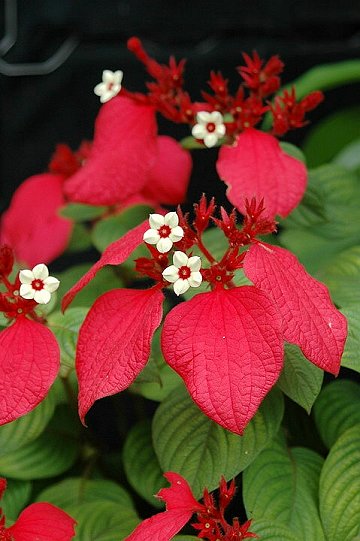
|
|
Ashanti blood
(Mussaenda erythrophylla).
Flowers and bracts.
|
Ashanti blood - Mussaenda erythrophylla
Mussaenda erythrophylla, commonly known as Ashanti blood, red flag bush and tropical dogwood, is an evergreen West African shrub. The bracts of the shrub may have different shades, including red, rose, white, pale pink or some mixtures. Mussaenda erythrophylla grows best in warmly temperate or subtropical areas and is semideciduous in cooler parts. In its natural habitat the shrub may scramble up to 10 m (33 ft), but is kept compact under cultivation. The star-like flowers of the shrub are 10 mm (0.39 in) in diameter and have a single, modified sepal.
The Mussaenda erythrophylla is native of Tropical Africa (Angola, Burundi, Cabinda, Cameroon, Ivory Coast, Gabon, Ghana, Guinea, Equatorial Guinea, Islands of the Gulf of Guinea, Kenya, Liberia, Nigeria, Central African Republic, Sierra Leone, Sudan, Tanganyka, Togo, Uganda and
Congo).
The name of the genus comes from word in Sinhalese language “mussenda”, with which are called locally some plants belonging to the genus.
The name of the species is the combination of the Greek words “erythros” = red and “phyllon” = leaf, with reference to the colour of its showy sepals.
Bush or small semi-deciduous tree which, in the wild, can reach the 6-8 metres of height, whilst, when in cultivation, is not usually taller than 1-2 m, showing intense green ovate leaves, pubescent and strongly veined, 8-15 cm long.
Said to be evergreen, but unless planted in very warm zone 10 or higher, mussaenda loses most or all leaves with cooler/cold weather until spring.
Plant mussaenda in full sun for best show of color which starts in spring in South Florida and lasts through summer and into the fall warm months.
The inflorescences are terminal panicles with tubular flowers with white or cream-white corolla, with a diameter of 2 cm, and red centre, with one of the five lobes of the calyx expanding considerably, so much to reach dimensions (5-12 cm), slightly inferior than the leaves, of a red colour.
The flowers are bisexual, but show the phenomenon of the heterostyly (difference in the length of the styles), that is to say that in some plants the flowers show a style longer than the anthers, in others, shorter and inside the corolla tube, which fosters the cross-fecundation. It usually reproduces by herbaceous or semi-woody cutting, and by air layering, as the plant seldom fructifies.
Poinsettia-like bracts surround the small white
flowers. The plant's color comes from bracts and not the small, often yellow, white or orange, flowers at the center of each bract.
This is the same color-producing system used by tropicals such heliconia and bougainvillea.
Mussaenda bracts may be seen in several colors including rose, white, red, pale pink and some mixtures.
As we know, during the winter seasons in temperate
zones, we have poinsettias in bloom. The evergreen mussaendas bloom the whole year
through. However, poinsettias and mussaendas are under different family
classifications.
Amply spread plant and appreciated in the tropical and subtropical regions, it requires a full sun exposition and a high humidity of the habitat and of the substratum, which must be sandy, rich of humus and draining; it requires timely pruning in order to keep a compact appearance. Is to be cultivated in humid-wet greenhouse when outside from the tropical and subtropical areas.
Source:
https://en.wikipedia.org/wiki/Mussaenda_erythrophylla
http://mgonline.com/articles/mussaenda.aspx
http://www.photomazza.com/?Mussaenda-erythrophylla
